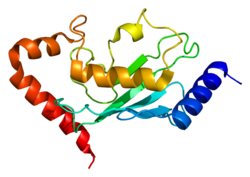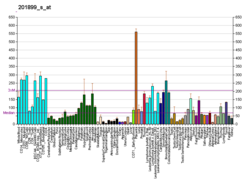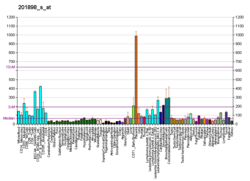Ubiquitin-conjugating enzyme E2 A is a protein that in humans is encoded by the UBE2A gene.[5][6]
The modification of proteins with ubiquitin is an important cellular mechanism for targeting abnormal or short-lived proteins for degradation. Ubiquitination involves at least three classes of enzymes: ubiquitin-activating enzymes, or E1s, ubiquitin-conjugating enzymes, or E2s, and ubiquitin-protein ligases, or E3s. This gene encodes a member of the E2 ubiquitin-conjugating enzyme family. This enzyme is required for post-replicative DNA damage repair. Multiple alternatively spliced transcript variants have been found for this gene and they encode distinct isoforms.[6]
Interactions edit
UBE2A has been shown to interact with RAD18,[7][8] UBR4[9] and P53.[10]
Clinical edit
Mutations in this gene have been associated with X-linked intellectual disability type Nascimento,[11] also known as Nascimento syndrome.[12] This syndrome is characterized by moderate to severe intellectual disability, dysmorphic facial features, seizures, speech impairment, motor delay, micropenis, and skin abnormalities.[11]
References edit
- ^ a b c GRCh38: Ensembl release 89: ENSG00000077721 – Ensembl, May 2017
- ^ a b c GRCm38: Ensembl release 89: ENSMUSG00000016308 – Ensembl, May 2017
- ^ "Human PubMed Reference:". National Center for Biotechnology Information, U.S. National Library of Medicine.
- ^ "Mouse PubMed Reference:". National Center for Biotechnology Information, U.S. National Library of Medicine.
- ^ Koken MH, Smit EM, Jaspers-Dekker I, Oostra BA, Hagemeijer A, Bootsma D, Hoeijmakers JH (March 1992). "Localization of two human homologs, HHR6A and HHR6B, of the yeast DNA repair gene RAD6 to chromosomes Xq24-q25 and 5q23-q31". Genomics. 12 (3): 447–453. doi:10.1016/0888-7543(92)90433-S. hdl:1765/3036. PMID 1559696.
- ^ a b "Entrez Gene: UBE2A ubiquitin-conjugating enzyme E2A (RAD6 homolog)".
- ^ Xin H, Lin W, Sumanasekera W, Zhang Y, Wu X, Wang Z (July 2000). "The human RAD18 gene product interacts with HHR6A and HHR6B". Nucleic Acids Research. 28 (14): 2847–2854. doi:10.1093/nar/28.14.2847. PMC 102657. PMID 10908344.
- ^ Tateishi S, Sakuraba Y, Masuyama S, Inoue H, Yamaizumi M (July 2000). "Dysfunction of human Rad18 results in defective postreplication repair and hypersensitivity to multiple mutagens". Proceedings of the National Academy of Sciences of the United States of America. 97 (14): 7927–7932. Bibcode:2000PNAS...97.7927T. doi:10.1073/pnas.97.14.7927. PMC 16647. PMID 10884424.
- ^ Barnsby-Greer L, Mabbitt PD, Dery MA, Squair DR, Wood NT, Lamoliatte F, Lange SM, Virdee S. UBE2A and UBE2B are recruited by an atypical E3 ligase module in UBR4. Nat Struct Mol Biol| doi: 10.1038/s41594-023-01192-4/
- ^ Lyakhovich A, Shekhar MP (April 2003). "Supramolecular complex formation between Rad6 and proteins of the p53 pathway during DNA damage-induced response". Molecular and Cellular Biology. 23 (7): 2463–2475. doi:10.1128/MCB.23.7.2463-2475.2003. PMC 150718. PMID 12640129.
- ^ a b Czeschik JC, Bauer P, Buiting K, Dufke C, Guillén-Navarro E, Johnson DS, et al. (September 2013). "X-linked intellectual disability type Nascimento is a clinically distinct, probably underdiagnosed entity". Orphanet Journal of Rare Diseases. 8: 146. doi:10.1186/1750-1172-8-146. PMC 4015352. PMID 24053514.
- ^ "Gene linked to severe learning disabilities governs cell stress response". ScienceDaily. 27 May 2022. Retrieved 9 September 2022.
Further reading edit
- Koken MH, Reynolds P, Jaspers-Dekker I, Prakash L, Prakash S, Bootsma D, Hoeijmakers JH (October 1991). "Structural and functional conservation of two human homologs of the yeast DNA repair gene RAD6". Proceedings of the National Academy of Sciences of the United States of America. 88 (20): 8865–8869. Bibcode:1991PNAS...88.8865K. doi:10.1073/pnas.88.20.8865. PMC 52611. PMID 1717990.
- Kato S, Sekine S, Oh SW, Kim NS, Umezawa Y, Abe N, et al. (December 1994). "Construction of a human full-length cDNA bank". Gene. 150 (2): 243–250. doi:10.1016/0378-1119(94)90433-2. PMID 7821789.
- Maruyama K, Sugano S (January 1994). "Oligo-capping: a simple method to replace the cap structure of eukaryotic mRNAs with oligoribonucleotides". Gene. 138 (1–2): 171–174. doi:10.1016/0378-1119(94)90802-8. PMID 8125298.
- Suzuki Y, Yoshitomo-Nakagawa K, Maruyama K, Suyama A, Sugano S (October 1997). "Construction and characterization of a full length-enriched and a 5'-end-enriched cDNA library". Gene. 200 (1–2): 149–156. doi:10.1016/S0378-1119(97)00411-3. PMID 9373149.
- Tateishi S, Sakuraba Y, Masuyama S, Inoue H, Yamaizumi M (July 2000). "Dysfunction of human Rad18 results in defective postreplication repair and hypersensitivity to multiple mutagens". Proceedings of the National Academy of Sciences of the United States of America. 97 (14): 7927–7932. Bibcode:2000PNAS...97.7927T. doi:10.1073/pnas.97.14.7927. PMC 16647. PMID 10884424.
- Xin H, Lin W, Sumanasekera W, Zhang Y, Wu X, Wang Z (July 2000). "The human RAD18 gene product interacts with HHR6A and HHR6B". Nucleic Acids Research. 28 (14): 2847–2854. doi:10.1093/nar/28.14.2847. PMC 102657. PMID 10908344.
- Miura T, Klaus W, Ross A, Güntert P, Senn H (January 2002). "The NMR structure of the class I human ubiquitin-conjugating enzyme 2b". Journal of Biomolecular NMR. 22 (1): 89–92. doi:10.1023/A:1013807519703. PMID 11885984. S2CID 27799378.
- Shekhar MP, Lyakhovich A, Visscher DW, Heng H, Kondrat N (April 2002). "Rad6 overexpression induces multinucleation, centrosome amplification, abnormal mitosis, aneuploidy, and transformation". Cancer Research. 62 (7): 2115–2124. PMID 11929833.
- Sarcevic B, Mawson A, Baker RT, Sutherland RL (April 2002). "Regulation of the ubiquitin-conjugating enzyme hHR6A by CDK-mediated phosphorylation". The EMBO Journal. 21 (8): 2009–2018. doi:10.1093/emboj/21.8.2009. PMC 125963. PMID 11953320.
- Suzumori N, Burns KH, Yan W, Matzuk MM (January 2003). "RFPL4 interacts with oocyte proteins of the ubiquitin-proteasome degradation pathway". Proceedings of the National Academy of Sciences of the United States of America. 100 (2): 550–555. Bibcode:2003PNAS..100..550S. doi:10.1073/pnas.0234474100. PMC 141033. PMID 12525704.
- Lyakhovich A, Shekhar MP (April 2003). "Supramolecular complex formation between Rad6 and proteins of the p53 pathway during DNA damage-induced response". Molecular and Cellular Biology. 23 (7): 2463–2475. doi:10.1128/MCB.23.7.2463-2475.2003. PMC 150718. PMID 12640129.
- Kunapuli P, Somerville R, Still IH, Cowell JK (May 2003). "ZNF198 protein, involved in rearrangement in myeloproliferative disease, forms complexes with the DNA repair-associated HHR6A/6B and RAD18 proteins". Oncogene. 22 (22): 3417–3423. doi:10.1038/sj.onc.1206408. PMID 12776193. S2CID 21536204.
- Rual JF, Venkatesan K, Hao T, Hirozane-Kishikawa T, Dricot A, Li N, et al. (October 2005). "Towards a proteome-scale map of the human protein-protein interaction network". Nature. 437 (7062): 1173–1178. Bibcode:2005Natur.437.1173R. doi:10.1038/nature04209. PMID 16189514. S2CID 4427026.
- Nascimento RM, Otto PA, de Brouwer AP, Vianna-Morgante AM (September 2006). "UBE2A, which encodes a ubiquitin-conjugating enzyme, is mutated in a novel X-linked mental retardation syndrome". American Journal of Human Genetics. 79 (3): 549–555. doi:10.1086/507047. PMC 1559544. PMID 16909393.






